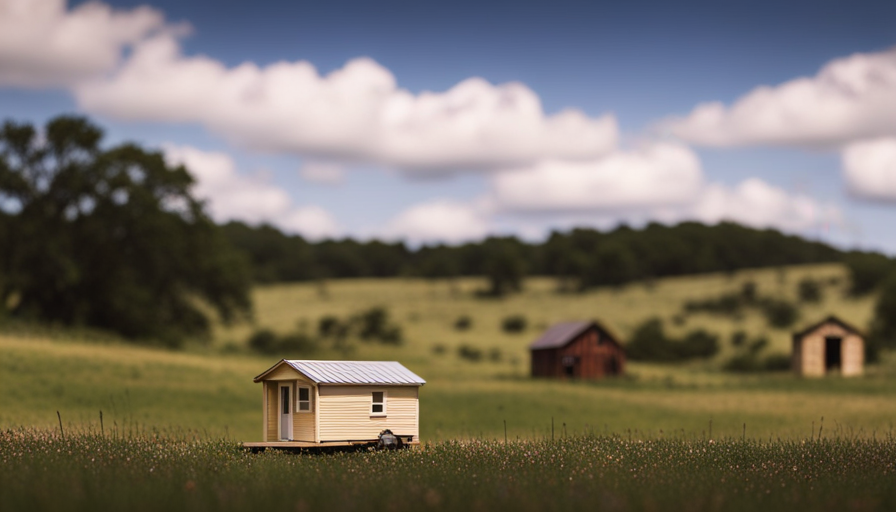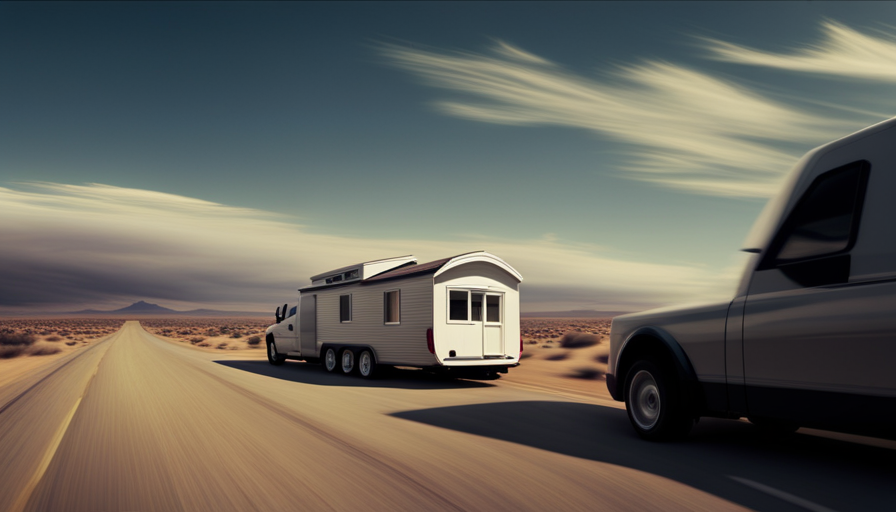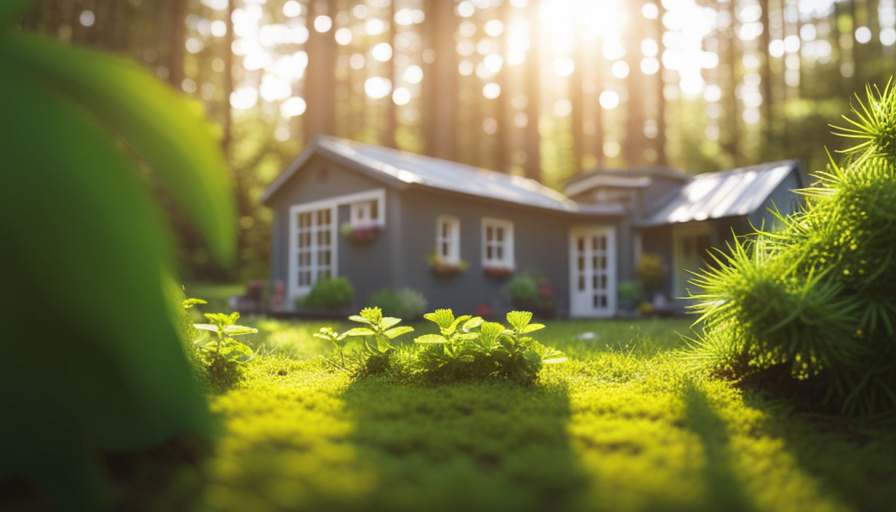Choosing the right BTU rating for your mini split system is crucial to effectively heat and cool your small home. But determining the exact number of BTUs needed can be overwhelming due to various factors to consider. That’s where my help comes in handy.
In this article, I will guide you through the process of calculating the perfect BTU rating for your tiny house mini split system. We’ll start by understanding the basics of BTU ratings and why they are important. Then, we’ll dive into calculating the square footage of your tiny house and considering the climate and location.
Next, we’ll explore how to determine the heating and cooling load specific to your tiny house. This step is essential in selecting a mini split system that can effectively handle your heating and cooling needs. We’ll also discuss installation and maintenance considerations, as well as additional features to look out for.
Lastly, I’ll provide you with reviews and recommendations based on real user experiences. By the end of this article, you’ll have all the knowledge you need to confidently choose a mini split system that will keep your tiny house comfortable year-round.
Let’s get started!
Key Takeaways
- Calculating BTU requirements involves considering square footage, energy efficiency, and insulation.
- High ceilings and large windows may require additional cooling or heating capacity.
- Energy efficiency ratios (EER and SEER) indicate how efficiently the system uses electricity.
- Determining heating and cooling load involves considering size, insulation, climate, windows, and doors.
Understanding the Basics of BTU Ratings
If you’re new to the world of HVAC, you might be wondering how many BTU a tiny house mini split needs. Understanding the basics of BTU ratings is crucial when determining the appropriate size for your mini split system.
BTU, or British Thermal Unit, is a unit of measurement used to quantify heat energy. It represents the amount of energy required to raise one pound of water by one degree Fahrenheit.
Calculating the BTU requirements for your tiny house involves considering several factors. First, you need to determine the square footage of your living space. This can be done by measuring the length and width of each room and multiplying these dimensions together.
Additionally, take into account any areas with high ceilings or large windows as they may require additional cooling or heating capacity.
Another important factor is energy efficiency. Mini splits come with different Energy Efficiency Ratios (EER) and Seasonal Energy Efficiency Ratios (SEER). These ratios indicate how efficiently the system uses electricity to cool or heat your home. Higher EER and SEER ratings mean more energy savings in the long run.
By calculating both square footage and energy efficiency factors, you can determine how many BTUs your tiny house mini split needs to effectively cool or heat your living space without wasting unnecessary energy.
Calculating the Square Footage of Your Tiny House
Calculate the square footage of your cozy abode to ensure optimal comfort and efficiency in keeping your small space cool or warm. When it comes to finding the right mini split system for your tiny house, accurately determining the square footage is crucial.
To calculate the square footage, measure the length and width of each room and multiply them together. Add up these measurements for all rooms, including any loft spaces or storage areas.
Once you have the total square footage, consider the insulation requirements of your tiny house. Insulation plays a vital role in maintaining an ideal temperature inside your home. Higher levels of insulation can reduce heat loss during winter and minimize heat gain during summer. This information is essential for selecting a mini split system with an appropriate BTU rating.
Now that you have calculated the square footage and assessed insulation needs, you can move on to considering the climate and location when choosing a mini split system for your tiny house. Factors like average temperatures throughout the year and humidity levels will influence both heating and cooling requirements. By taking these factors into account, you can ensure that your mini split system delivers optimal performance in any weather condition.
Continuing onto considering the climate and location…
Considering the Climate and Location
Taking into account the weather conditions and geographical location, it’s important to choose a mini split system that can weather the storm and keep your cozy abode comfortable all year round. Climate change has resulted in more extreme weather patterns, making it crucial to consider the climate and location when selecting a mini split system for your tiny house. The energy consumption of a mini split system depends on various factors such as outdoor temperature, insulation level, and square footage.
To give you an idea of how climate affects energy consumption, refer to the table below:
| Climate Zone | Cooling Load (BTU/h) | Heating Load (BTU/h) |
|---|---|---|
| Hot | 12,000 | 15,000 |
| Moderate | 9,000 | 12,000 |
| Cold | 6,000 | 9,000 |
Understanding these load requirements will help you determine the appropriate BTU capacity for your mini split system. In addition to considering climate and location factors like average temperatures and humidity levels are also essential. By analyzing these variables thoroughly, you can choose a mini split system that will efficiently heat or cool your tiny house while minimizing energy consumption.
Transitioning into the subsequent section about determining the heating and cooling load involves further analysis of specific factors related to your tiny house’s insulation levels and other unique characteristics.
Determining the Heating and Cooling Load
Considering the insulation levels and specific characteristics of your cozy abode, it’s crucial to determine the heating and cooling load. This will help you select an appropriate system. Estimating the heating and cooling load involves calculating the amount of heat gain or loss that occurs within your tiny house. To accurately size and determine the capacity requirements for a mini split system, here are some important factors to consider:
-
Size: The square footage of your tiny house plays a significant role in determining the BTU (British Thermal Unit) capacity needed for efficient heating and cooling.
-
Insulation: The insulation levels in your tiny house impact its energy efficiency. A well-insulated home requires less heating and cooling capacity compared to one with poor insulation.
-
Climate: The climate in your location affects the temperature extremes you may experience, influencing the required BTU output of your mini split system.
-
Windows and Doors: The number, size, and quality of windows and doors affect heat transfer. It’s essential to account for their impact on the overall heating and cooling load estimation.
Determining the heating and cooling load estimation helps ensure that you choose a mini split system that can adequately meet your comfort needs without unnecessary energy waste.
Now let’s move on to choosing the right mini split system for your tiny house.
Choosing the Right Mini Split System
To select the perfect system for your cozy abode, envision the ideal mini split system that will effortlessly maintain a comfortable climate inside your tiny retreat. When choosing a mini split system for your tiny house, it’s essential to calculate the BTU requirements accurately.
This calculation involves evaluating factors such as the size of your space, insulation levels, and desired temperature range. By determining the heating and cooling load accurately, you can ensure that you choose a mini split system with enough capacity to efficiently heat or cool your tiny home.
In addition to calculating the BTU requirements, it’s crucial to consider the long-term cost effectiveness of the mini split system. While some units may have a higher initial cost, they may offer greater energy efficiency in the long run, leading to lower operating costs over time. It’s important to weigh these factors carefully when making your decision.
When considering energy efficiency and operating costs, it’s essential to look beyond just the initial price tag of the unit. Evaluating factors such as SEER (Seasonal Energy Efficiency Ratio) ratings and HSPF (Heating Seasonal Performance Factor) can give you insights into how efficient a particular system is at both cooling and heating. By considering all these aspects together, you can select a mini split system that not only meets your BTU requirements but also offers optimal energy efficiency and operating costs.
Transitioning into the subsequent section about ‘energy efficiency and operating costs,’ it becomes clear that choosing an appropriate mini split system requires careful consideration of various technical aspects to create a comfortable environment while keeping long-term expenses in check.
Energy Efficiency and Operating Costs
Maximize your comfort while minimizing expenses by choosing an energy-efficient mini split system with low operating costs. When it comes to energy efficiency, it’s crucial to consider the Seasonal Energy Efficiency Ratio (SEER) and the Heating Seasonal Performance Factor (HSPF). These ratings indicate how efficiently the system operates in both cooling and heating modes. The higher the SEER and HSPF ratings, the more energy-efficient the mini split system is, resulting in lower operating costs.
To determine the cost analysis of a mini split system, you should consider not only the initial purchase price but also long-term expenses like electricity bills. Look for systems that have advanced features such as programmable timers and smart controls that allow you to optimize energy usage based on your schedule. Additionally, some models offer variable-speed compressors that adjust their output based on specific temperature requirements, further improving energy efficiency.
When considering installation and maintenance considerations, keep in mind that proper installation plays a significant role in maximizing energy efficiency. It’s important to hire a professional who can ensure proper sizing and placement of the unit for optimal performance. Regular maintenance, such as cleaning or replacing filters and keeping outdoor units free from debris, will also help maintain efficiency over time.
Transitioning into the subsequent section about ‘installation and maintenance considerations,’ it’s vital to understand these factors to make an informed decision about your mini split system’s overall performance and longevity.
Installation and Maintenance Considerations
Proper installation and regular maintenance are essential for ensuring optimal performance and longevity of your mini split system. Studies show that well-maintained systems can operate at peak efficiency for up to 15 years.
Installation Tips:
- Choose a suitable location for the outdoor unit, considering factors like airflow, accessibility, and noise concerns.
- Ensure proper insulation of refrigerant lines to minimize energy loss.
- Follow manufacturer guidelines for electrical wiring connections to prevent damage and ensure safety.
Maintenance Checklist:
- Clean or replace air filters regularly to maintain airflow and prevent dust accumulation.
- Keep the outdoor unit clear of debris such as leaves or vegetation that could obstruct airflow.
- Inspect refrigerant lines for leaks or damage and repair if necessary.
Regularly checking these items on your installation and maintenance checklist will help maximize the efficiency and lifespan of your mini split system. By taking proactive measures during installation and adhering to a consistent maintenance routine, you can avoid potential issues that may arise from neglect. These practices will also contribute to reducing operating costs in the long run.
Now let’s discuss some additional features and considerations when selecting a mini split system.
Additional Features and Considerations
When considering a mini split for a tiny house, it’s important to take into account additional features and considerations. Two key points to consider are the Wi-Fi connectivity and smart controls. These features allow for easy remote access and control of the unit, providing convenience and energy efficiency.
Another consideration is the noise levels and aesthetics of the mini split. It’s crucial to choose a unit that operates quietly while also blending seamlessly with the overall design of the tiny house.
Wi-Fi connectivity and smart controls
To enhance your experience, you can easily connect your mini-split system to Wi-Fi and enjoy the convenience of smart controls. With Wi-Fi compatibility, you can remotely control your tiny house’s temperature and settings through a smartphone app or voice commands.
The benefits of smart controls include increased energy efficiency by allowing precise temperature scheduling, optimizing comfort while minimizing energy consumption. Additionally, the ability to monitor and adjust your mini-split system remotely ensures that you always come home to a comfortable living space.
Furthermore, smart controls enable you to receive notifications about maintenance reminders or when it’s time to change filters, ensuring optimal performance and longevity of your mini-split system. Transitioning into the subsequent section about noise levels and aesthetics, it is important to consider these factors as they contribute to overall satisfaction with your tiny house HVAC system setup.
Noise levels and aesthetics
Moving on from the convenience of Wi-Fi connectivity and smart controls, let’s now delve into another important aspect when choosing a mini split for your tiny house: noise levels and aesthetics. While it is crucial to have an efficient cooling and heating system, it is equally important to consider its acoustic performance as well as how it will blend seamlessly with the design of your tiny home. To help you make an informed decision, I have prepared a table comparing different mini split models based on their noise levels and design options:
| Model | Noise Levels (dB) | Design Options |
|---|---|---|
| A | 25-30 | Option 1 |
| B | 20-25 | Option 2 |
| C | 30-35 | Option 3 |
By carefully considering both the acoustic performance and design options, you can ensure that your chosen mini split not only provides optimal comfort but also enhances the overall aesthetic appeal of your tiny house. Now let’s move on to reviews and recommendations for further guidance in selecting the perfect mini split for your needs.
Reviews and Recommendations
When it comes to popular mini split brands and models for tiny houses, I can share from my real-life experiences and testimonials from other tiny house owners.
One of the top brands that consistently receives positive reviews is Fujitsu. Their mini split models, such as the ASU9RLS3Y and the ASU12RLS3Y, are known for their efficiency and quiet operation.
Additionally, Mitsubishi Electric is another reputable brand with highly recommended options like the MSZ-FH09NA and the MSZ-FH12NA.
Popular mini split brands and models for tiny houses
Looking for the perfect mini split brand and model for your tiny house? Look no further, because we’ve got some recommendations that will blow you away! When it comes to popular mini split brands for tiny houses, there are a few standout options to consider. Mitsubishi Electric, Fujitsu General, and LG are all well-known brands that offer reliable and efficient ductless mini split systems.
In order to help you make an informed decision, here is a table comparing these three brands:
| Brand | Pros | Cons |
|---|---|---|
| Mitsubishi Electric | High energy efficiency Quiet operation Advanced features |
Higher initial cost |
| Fujitsu General | Energy-efficient Wide range of models available Durable |
May require professional installation |
| LG | Sleek design Smart functionality User-friendly controls |
Some models may have lower energy efficiency ratings |
These popular mini split brands offer various advantages and disadvantages depending on your specific needs. Now let’s delve into real-life experiences and testimonials from tiny house owners.
Real-life experiences and testimonials from tiny house owners
If you want to hear firsthand experiences and testimonials, tiny house owners have shared their real-life stories about the mini split brands they chose. These accounts provide valuable insight into the performance and customer satisfaction of different models.
Many owners report positive experiences with mini splits in their tiny houses, noting that these systems effectively cool and heat their small spaces while consuming minimal energy. They appreciate the compact size of mini splits, which fits seamlessly into the limited space available in a tiny house. Some owners even mention how easy it was to install and maintain their chosen mini split brand.
These real-life experiences highlight the reliability and efficiency of various models, helping potential buyers make an informed decision when selecting a mini split for their own tiny house.
Transitioning into the next section about ‘conclusion and final tips’, it is important to consider all aspects before making your purchase decision.
Conclusion and Final Tips
To ensure optimal comfort and energy efficiency in your tiny house, don’t forget to consider the BTU capacity of your mini split system. Trust me, you’ll be amazed at the difference it makes!
Here’s a conclusion summary and final buying guide to help you make the right decision:
-
Calculate your heating and cooling needs: Determine the square footage of your tiny house and consider factors such as insulation levels, climate conditions, and number of occupants. This will give you an idea of how many BTUs you need for efficient temperature control.
-
Choose the right BTU capacity: Mini split systems come in various BTU capacities, ranging from 6,000 to 36,000 BTUs or more. It’s crucial to select a unit that matches your calculated heating and cooling needs. Undersized units may struggle to maintain desired temperatures while oversized ones can waste energy.
-
Seek professional guidance: Consulting with HVAC professionals or experienced tiny house owners can provide valuable insights and recommendations based on their real-life experiences.
Selecting the appropriate BTU capacity for your mini split system is vital for achieving optimal comfort and energy efficiency in your tiny house. Take the time to calculate your heating and cooling needs accurately, choose the right BTU capacity, and seek expert advice if needed. By following these steps, you’ll be well-equipped to make an informed decision when purchasing a mini split system for your tiny house.
Frequently Asked Questions
Can I use a mini split system to heat and cool my tiny house in extreme climates?
Yes, a mini split system can be used to effectively heat and cool a tiny house in extreme climates. The efficiency of a mini split system allows for optimal temperature control while minimizing energy consumption. However, it’s important to consider the size and insulation of your tiny house when choosing the appropriate BTU capacity for your mini split system.
Additionally, while the upfront cost of a mini split system may be higher compared to other heating and cooling options, its long-term energy savings make it a cost-effective choice.
How much noise does a mini split system produce?
The noise level of a mini split system can vary depending on the model and installation. However, there are techniques to reduce the noise produced by these systems.
Some common noise reduction techniques include using insulated ducts, installing soundproofing materials around the unit, and placing the outdoor condensing unit away from living areas. These measures help minimize any potential disturbance caused by the operation of a mini split system in your tiny house.
What are the advantages of using a mini split system over other heating and cooling options for a tiny house?
The advantages of using a mini split system in a tiny house are numerous. Firstly, mini splits are highly energy-efficient, allowing for significant cost savings on heating and cooling bills.
Additionally, these systems offer precise temperature control in individual rooms, ensuring maximum comfort. Mini splits also operate quietly compared to traditional HVAC systems, minimizing noise disruptions in the tiny house environment.
Overall, the energy efficiency and customizable comfort make mini splits an ideal choice for heating and cooling small spaces like tiny houses.
Are there any government incentives or rebates available for installing a mini split system in a tiny house?
Yes, there are indeed government incentives and rebates available for installing energy-efficient mini split systems in tiny houses. These incentives are a godsend! They provide financial relief and make the decision to go with a mini split system even more appealing.
By choosing an energy-efficient option like a mini split system, you not only save money on utility bills but also contribute to a greener environment. So, take advantage of these government incentives and make your tiny house both comfortable and eco-friendly!
Can I install a mini split system in a tiny house myself, or do I need to hire a professional?
I highly recommend hiring a professional to install a mini split system in a tiny house. While it’s possible to do it yourself, there are several benefits of professional installation.
Professionals have the expertise and knowledge to ensure proper sizing and installation, maximizing efficiency and performance. They can also handle any electrical or refrigerant work required, ensuring safety and compliance with regulations.
Overall, professional installation guarantees a reliable and efficient mini split system for your tiny house.
Conclusion
After considering the basics of BTU ratings and calculating the square footage, it’s crucial to choose the right mini split system for your tiny house. Determining the heating and cooling load should also be taken into account. Additionally, installation and maintenance should be considered to ensure optimal performance. It’s also worth looking into additional features such as energy efficiency and smart technology, as they can enhance your comfort level. Reviews and recommendations can guide you towards making an informed decision. In conclusion, selecting the perfect mini split system will create a cozy haven in your tiny house, keeping you cool in summer and warm in winter.
Hi, I’m Emma. I’m the Editor in Chief of Tiny House 43, a blog all about tiny houses. While tree houses are often associated with childhood, they can be the perfect adult retreat. They offer a cozy space to relax and unwind, surrounded by nature. And since they’re typically built on stilts or raised platforms, they offer stunning views that traditional homes simply can’t match. If you’re looking for a unique and romantic getaway, a tree house tiny house might just be the perfect option.










